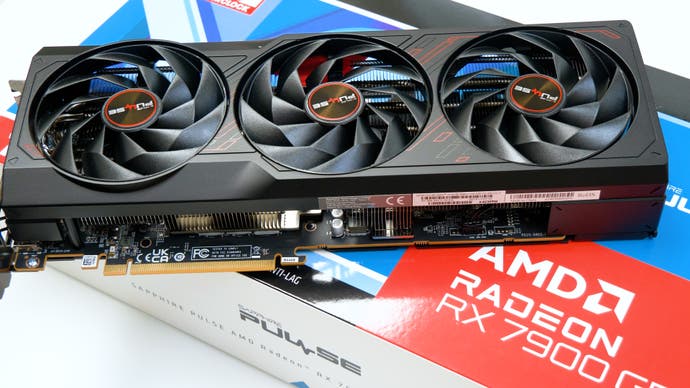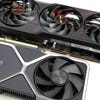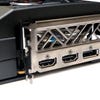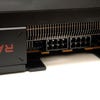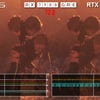AMD Radeon RX 7900 GRE review: the most compelling RDNA 3 graphics card yet
Good at RT, stellar at rasterisation, at a price that's right - this is AMD at its most aggressive.
In something of a surprise launch, AMD has made its RX 7900 GRE available as a full retail product in order to tackle the challenge represented by Nvidia's successful RTX 4070 Super. Previously available in the Chinese region and selectively to the OEM market elsewhere, the idea is very straightforward. Similar to the well-received RX 7800 XT, AMD readily admits that it lacks the same level of ray tracing performance of its closest Nvidia counterpart, but makes up for it in spades elsewhere. RX 7900 GRE has 16GB of framebuffer memory where the 4070 Super has just 12GB, paired with a 256-bit interface where the Nvidia card has a 192-bit bus. It's also significantly faster in rasterisation.
In effect, AMD is delivering excellent value for users who still aren't fully buying into the ray tracing dream, or aren't enamoured with Nvidia's ever-growing feature set. Clearly, we believe that those features have a great deal of value, but the point is that if you disagree and if you want a fast card with all the memory you'll need for the foreseeable future, AMD is delivering what Nvidia does not - and it's doing it for less money. It's that simple.
First up, let's consider what the RX 7900 GRE actually is. The name itself is curious, hailing from its Chinese market origins, where GRE stands for Golden Rabbit Edition to mark 2023 in the Chinese zodiac. It's a baffling choice for any other market and doesn't really slot in convincingly into the existing brand, but then again, some might say that any three letters are as good as any other.
More interesting is the make-up of the card itself, which is essentially a further cut down version of the RX 7900 XTX and RX 7900 XT. Similar to those cards, the GRE is based on a chiplet design - a 5nm compute processor surrounded by separate 6nm memory controllers. The XTX has six of those MCDs active, the GRE has just four. A 384-bit interface becomes 256-bit and 24GB of VRAM drops to 16GB. Cutbacks to the compute die, the GCD, are rather more restrained. 96 RDNA 3 compute units in the XTX fall to 84 in the XT, with a further haircut to 80 in the GRE. This is accompanied by lower clocks too.
In essence then, AMD strategically shaves memory and bandwidth, disables more compute units and reduces the frequency to deliver a product that - as our benchmarks reveal - almost literally sits in the middle performance-wise when we look at the 7900 GRE amongst the 7800 XT and 7900 XT. In fact, when you compare the GRE to the 7800 XT, there's a significant specs gulf, which does make you wonder what 'secret sauce' the Navi 32 processor has that the (relatively) more capable Navi 31 does not.
| RDNA 3 GPUs | RX 7700 XT | RX 7800 XT | RX 7900 GRE | RX 7900 XT |
|---|---|---|---|---|
| Processor | Navi 32 | Navi 32 | Navi 31 | Navi 31 |
| Compute units | 54 | 60 | 80 | 84 |
| Game clock | 2171MHz | 2124MHz | 1880MHz | 2000MHz |
| Boost clock | 2544MHz | 2430MHz | 2245MHz | 2400MHz |
| GDDR6 memory | 12GB | 16GB | 16GB | 20GB |
| Memory interface | 192-bit | 256-bit | 256-bit | 320-bit |
| Memory speed | 18Gbps | 19.5Gbps | 18Gbps | 20Gbps |
| Infinity Cache | 48MB | 64MB | 64MB | 80MB |
| TDP | 245W | 263W | 260W | 315W |
| RRP | $449/£429 | $499/£479 | $550/£519 | $899/£899 |
For review, we received the Sapphire Pulse rendition of the RX 7900 GRE. There's no reference design available for the GRE as it's produced only by add-in board manufacturers (AIBs). It's a dual-slot, tri-fan design that is rather large - postively dwarfing the RTX 4070 Super Founders Edition - with a plastic shround and metal backplate. Power is delivered via two eight-pin PCIe inputs, and its 260W TDP does mean that in efficiency terms, it will lag behind the competing Nvidia offerings on the Ada Lovelace architecture.
In terms of the rest of its I/O, the Pulse is a little different to the norm, delivering two HDMI 2.1 ports, along with two DisplayPort 2.1s. Yes, a more modern display processor does give the Radeon cards an advantage over Nvidia, with more video bandwidth available for the most cutting-edge displays - with no video compression required.
Sapphire is a trusted brand and close partner of AMD and I've no complaints with the Pulse edition of the card sent for review - aside from, perhaps, its rather substantial length. There's no appreciable noise, and no bugs at all were discovered during testing.
I'm going to kick off performance testing with something a little different. Recently, we've sought to look at GPU performance on a per-game title more holistically by comparing performance with the output of the PlayStation 5 - a prime target platform for developers. We isolate titles where we can get a settings match between console and PC, then locate areas where PlayStation 5 fails to hit its performance target (ie, where we've found the limits of GPU performance). Then we match those circumstances on PC with an unlocked frame-rate and see what kind of performance multipliers we get.
When we start to look at products like RTX 4070, RX 7800 XT, RX 7900 GRE and RTX 4070 Super, you realise that $500-$600 buys you literally game-changing performance when stacked up against the consoles. At its best, you're looking at twice the throughput in matched settings, or better. Games running at 30fps on PS5 hit 60fps on this class of PC hardware. Similarly, 'performance modes' on PS5 targeting 60fps now take you into the VRR sweetspot on 1440p and even 4K displays. We can talk about how individual GPUs compare to one another, but this holistic look at game performance also shows you the advantages of optimised settings - the best bang for GPU buck - as established by game developers themselves.
Mirroring Alan Wake 2's quality mode on PC, a sub-30fps readout moves beyond 60fps on 7900 GRE and RTX 4070 Super. The GRE has a 2.29x performance multiplier over PS5, dropping to 2.15x on 4070 Super. With no RT in play, the AMD offering beats Nvidia by around 12 percentage points. Meanwhile, in matched settings in Avatar: Frontiers of Pandora, the GRE offers 88 percent more performance than PS5, rising to a 2.33x multiplier with the RTX 4070 Super thanks to its superior RT throughput. That's a 24 point Nvidia advantage over AMD.
Sticking with RT, a performance hot spot in Cyberpunk 2077: Phantom Liberty sees the PS5 fail to hit its 30fps target. Here, the GRE offers 77 percent more performance than the console, rising to an even more impressive 2.21x increase in frame-rate on the RTX 4070 Super on matching settings - it's 15 percent faster than the GRE. Moving back to rasterisation, the RX 7900 GRE takes point in A Plague Tale: Requiem, with a startling 2.16x performance increase over the PlayStation 5 in like-for-like testing, with the 4070 Super delivering 92 percent more frames than the console (a 12 point lead for the GRE over the Super).
All of our GPU testing here was carried out using a system with 32GB of Gskill 6000MT/s DDR5 paired with a Core i9 13900K running on an Asus Maximus Hero Z690 motherboard with a Corsair RM1000 power supply. All games were run from PCIe 3.0 storage, with the CPU cooled by a Noctua D15 air cooler. And with that, it's time to move on to more conventional benchmark testing on the following pages.
AMD Radeon RX 7900 GRE analysis:
- Introduction [This Page]
- RT benchmarks: Dying Light 2, Cyberpunk 2077, Control
- RT benchmarks: Metro Exodus Enhanced Edition, F1 22, Marvel's Spider-Man: Miles Morales
- RT/DLSS/FSR2/DLSS3 benchmarks: Cyberpunk 2077, Dying Light 2, Forza Horizon 5, Marvel's Spider-Man: Miles Morales
- Game benchmarks: Control, Cyberpunk 2077, F1 22, Forza Horizon 5
- Game benchmarks: Hitman 3, A Plague Tale: Requiem, Returnal, Marvel's Spider-Man: Miles Morales
- Conclusions, value and recommendations
